
The $449 eight-core Ryzen 7 7800X3D is the new high-performance gaming champion for the desktop PC. Even though the Ryzen 7 7800X3D is much less expensive than its competitors, it’s still 12% faster in gaming on average than Intel’s $580 flagship Core i9-13900K and up to 40% faster in some titles, and it also beats the fastest gaming CPU currently available — AMD’s own $699 16-core Ryzen 9 7950X3D.
AMD’s exotic second-gen 3D V-Cache tech powers the 7800X3D’s incredible gaming performance by boosting the chips' L3 cache capacity to an incredible 96MB via a 3D-stacked chiplet, assuring it a top spot on our list of the best CPUs for gaming.
The Ryzen 7 7800X3D has big shoes to fill — the first-gen 3D V-Cache (X3D) chip, the Zen 3-powered Ryzen 7 5800X3D, has become the go-to chip for high-performance gaming at an accessible price point, and it continues to be a favorite. Like its predecessor, the Ryzen 7 7800X3D is specifically designed to blast through CPU-limited games with previously-unseen levels of performance, but the tech doesn’t accelerate all games and can result in lower performance in some productivity applications than the standard Ryzen 7000 models.
However, while the 5800X3D used the Zen 3 architecture and 7nm process, the 5nm Ryzen 7 7800X3D comes with the newer Zen 4 architecture and a much higher 5.0 GHz peak boost, helping to assure a more steady blend of performance in productivity workloads. AMD has also unlocked the 7800X3D for basic overclocking and undervolting, another advantage over the prior-gen model.
Simplicity is a key advantage for the Ryzen 7 7800X3D. AMD broadened its X3D family with the Zen-4 powered $699 16-core Ryzen 9 7950X3D and $599 12-core Ryzen 9 7900X3D. These heftier models deliver incredible gaming performance in tandem with more cores for the productivity minded, but they have multiple compute chiplets that require AMD’s innovative new thread-targeting tech to extract the best performance. In contrast, the Ryzen 7 7800X3D has a single compute chiplet and should provide more of a plug-and-play experience that doesn’t require additional thread-targeting/software handholding.
Simple, fast, and efficient is the goal, and AMD's chip mostly delivers on those goals. If peak gaming performance is your only concern and you have the budget, we found that the Ryzen 7 7800X3D doesn’t leave much room for any other chip — it stands far above the rest. That said, Intel isn't sitting idly on the sideline, either, as its Raptor Lake alternatives offer their own advantages. Let’s see how the chips stack up in our gaming benchmarks on the following pages.
AMD Ryzen 7 7800X3D Pricing and Specifications
AMD foreshadowed the arrival of the Ryzen 7 7800X3D when it first unveiled its Ryzen 7000 lineup with a glaring '7800X'-sized hole between the Ryzen 7 7700X and Ryzen 9 7900X. In terms of gaming performance, the Ryzen 7 7800X3D slots in against (and beats) Intel's $580 24-core 32-thread Core i9-13900K, but it is more closely matched to the $417 16-core 24-thread Core i7-13700K in terms of pricing and performance in productivity applications.
The 7800X3D is somewhat similar to the Zen 3-powered Ryzen 7 5800X3D, with both chips having eight cores, 16 threads, and 3D V-Cache tech, but the similarities stop there. The Ryzen 7 7800X3D steps up to the Zen 4 architecture and has a 500 MHz higher boost frequency of 5.0 GHz and an 800 MHz higher base clock of 4.2 GHz, all of which delivers much more performance in gaming and a more diverse range of applications. As we'll show on the following page, AMD could've clocked the 7800X3D higher but chose to stop at 5.0 GHz.
Of the modern Zen 4 family, the Ryzen 7 7700X is the closest comparison with the same allotment of eight cores and 16 threads, but it comes without the 3D stacking tech and has a 300 MHz higher base and 400 MHz higher boost clock than the 7800X3D. That's because the Ryzen 7 7800X3D comes with eight cores on a single compute die that's augmented with the 7nm SRAM slice of L3 cache hybrid-bonded on top of the silicon. This cache chiplet creates thermal challenges you can read about here, ultimately leading to a 1.1V voltage limitation and lower peak frequencies than standard chips, a required accommodation to keep thermals in check.
AMD's 3D V-Cache tech takes the key advantage of chiplet-based design methodologies into the third dimension by stacking an older and less-expensive 7nm process node on top of cores etched on the expensive new 5nm process tech. As with all other 3D V-Cache chiplets, the 3D-stacked SRAM L3 chip weighs in at 64MB. As a result, the 7800X3D comes with 104MB of total cache, with 96MB of that being gaming-boosting L3 cache. The additional L3 cache chiplet has a peak bandwidth of 2.5 TB/s, which is 25% faster than the previous-gen implementation. You can read the finer-grained details of the Second-Gen 3D V-Cache tech here.
AMD’s Zen 4 3D V-Cache processors all have a base TPD of 120W and a max 162W PPT, meaning the 7800X3D’s ratings are 15/20W higher than the 105W/142W rating for the standard 7700X. In contrast, the multi-chiplet 7950X3D and 7900X3D have lower power thresholds than their equivalents because the additional cache chiplet results in slightly higher operating temperatures that need to be kept within a safe range.
The Ryzen 7 7800X3D's higher TDP threshold doesn't make much sense, though — as you'll see on the following pages, the chip never came close to its rated power limits, and thermals were easy to tame. Speaking of which, the 7800X3D’s maximum supported temperature is 89C, lower than the 7700X’s limit of 95C. The 7800X3D doesn’t come with a bundled cooler — AMD recommends a 280mm water cooler, or better, for the Ryzen 7000X3D processors.
As with all Ryzen 7000 chips, the Ryzen 7 7800X3D's RDNA 2 integrated GPU has two compute units, 4 ACE, and 1 HWS. This unit doesn't have the necessary horsepower to benefit from faster CPU cores — it is entirely GPU compute-bound. The iGPU also doesn't benefit from the 3D V-Cache tech because it resides on the I/O die and can't access the L3 cache, so performance is the same as the regular Ryzen 7000 processors (see more in our X3D iGPU testing).
The previous-gen Ryzen 7 5800X3D uses the aging AM4 platform with less advanced interfaces, like PCIe 4.0 and DDR4 memory, while the Ryzen 7 7800X3D snaps into AM5 motherboards that support the latest connectivity tech, like DDR5 and PCIe 5.0. AMD only allowed overclocking the memory and Infinity Fabric for the previous-gen 5800X3D but now allows both the auto-overclocking Precision Boost Overdrive (PBO) and Curve Optimizer. AMD still doesn’t allow direct frequency overclocking due to the aforementioned voltage limitation due to the 3D V-Cache. We have plenty of testing with those features on the following pages — head to our overclocking page for the details.

Even though we did run into a snag in our testing due to a driver anomaly that we reported to AMD, the Ryzen 7 7800X3D should benefit from the simplicity of a single compute chiplet design. (Update 4/16/2023: These chips are now at retail for roughly two weeks, but we haven't heard of any reports of this issue, which is a positive sign.)
The Ryzen 9 7950X3D and the 7900X3D have two eight-core Core Compute Die (CCD) chiplets paired with a central I/O Die, marking the first time AMD brought the 3D V-Cache tech to a multi-CCD processor. The above image shows that AMD only mounts a single 7nm SRAM chiplet atop one of the two eight-core CCDs, leaving the other bare. This means that each type of chiplet is best suited for different types of work — the 3D V-Cache enabled chiplet is best for cache latency-sensitive tasks like gaming, and the standard chiplet is for workloads that respond best to higher frequencies.
You can read the deep-dive details on AMD's thread-targeting implementation here, but the key takeaway is that it requires four different components to work together to alter the thread assignments into the cores automatically.
In contrast, while we don't have an image of a delidded Ryzen 7 7800X3D (or even a render), it comes with only one of the two smaller rectangular CCDs seen in the image. This means that none of those mechanisms are required to direct the threads to the correct chiplet — there is only one chiplet, so the processor performs as normal. Let's see what performance looks like on the following pages.
- MORE: AMD Ryzen 7 7800X3D vs Intel Core i9-13900K vs Core i7-13700K
- MORE: Best CPU for gaming
- MORE: CPU Benchmark Hierarchy
- MORE: Intel vs AMD
- MORE: How to Overclock a CPU
AMD Ryzen 7 7800X3D Power Consumption and Efficiency





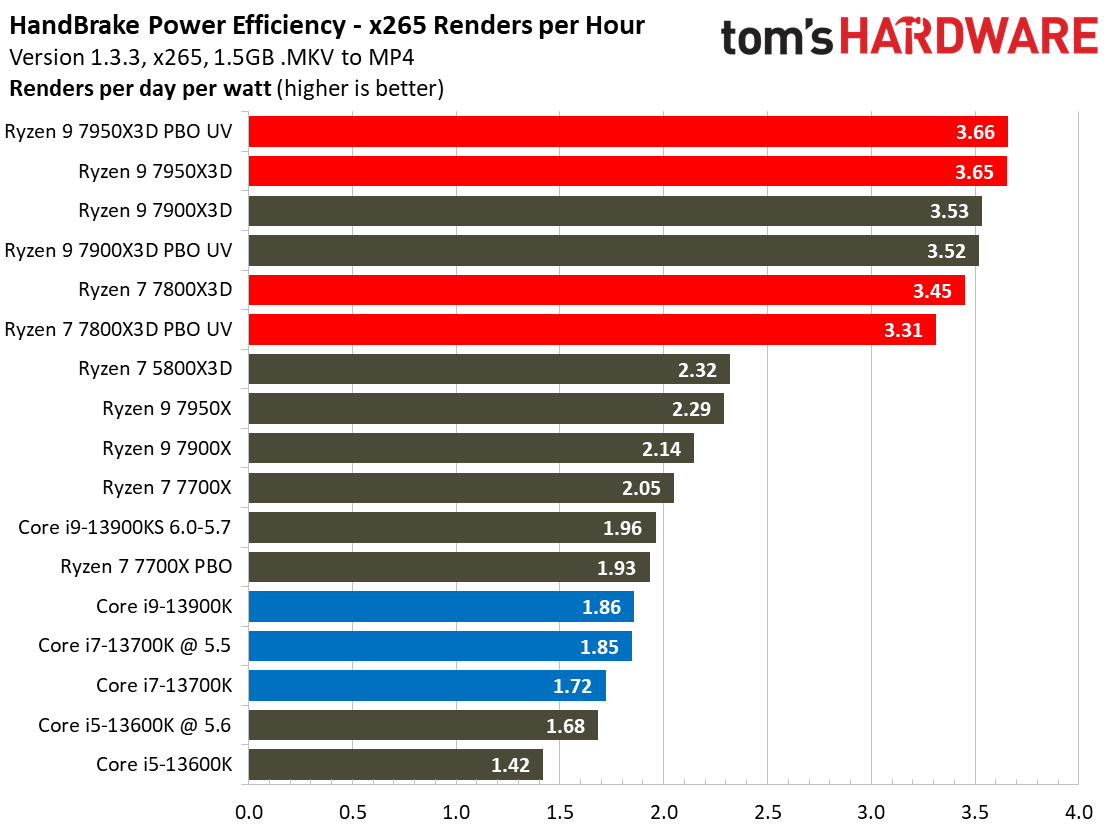

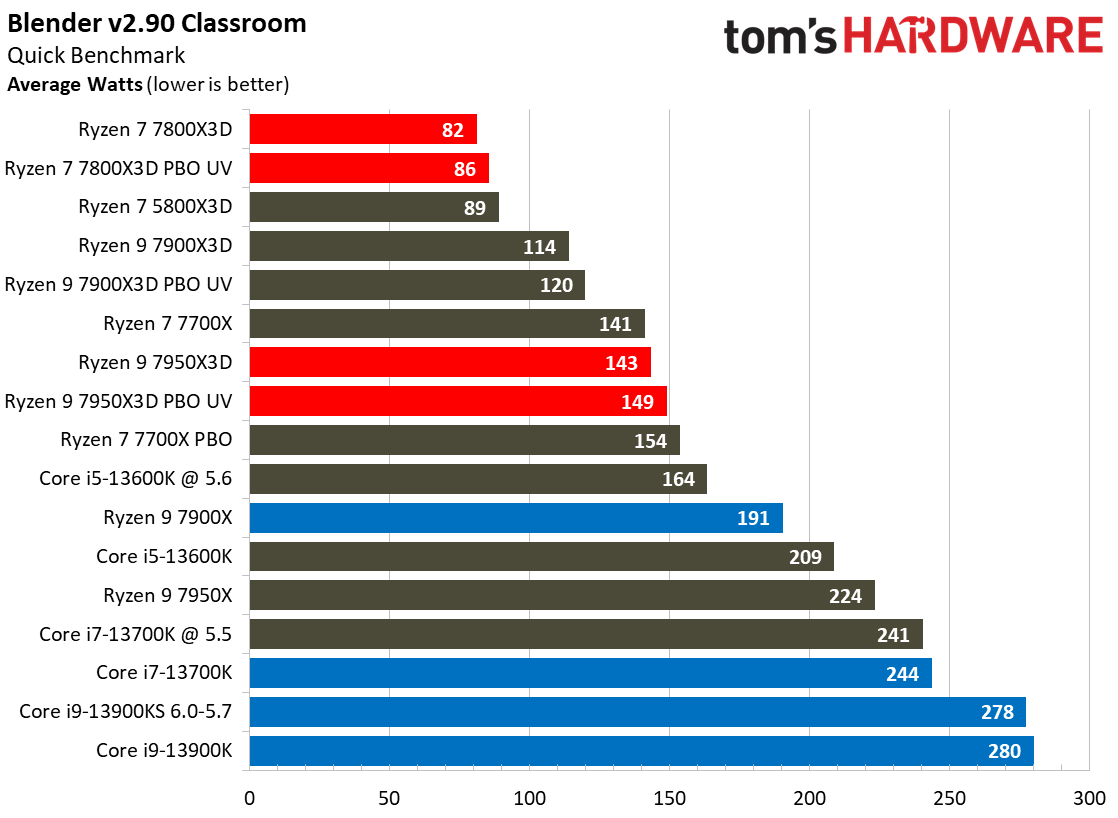

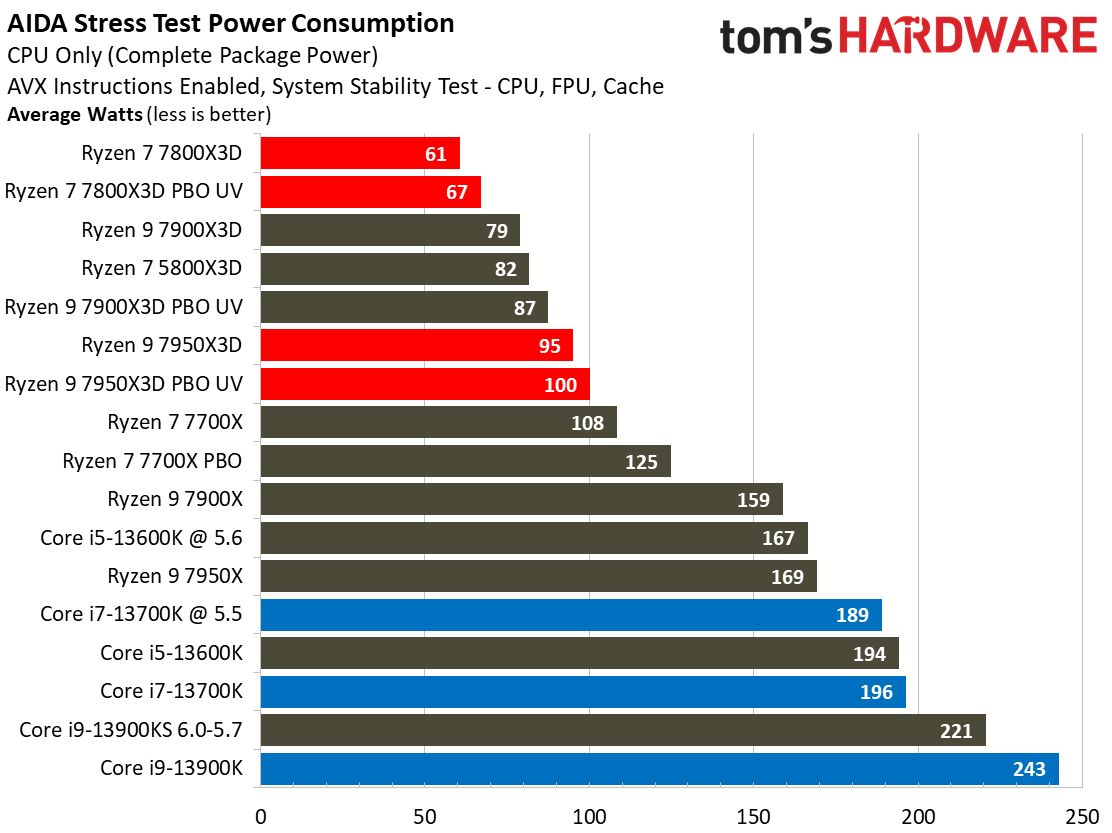

AMD's Ryzen chips have excellent power and efficiency metrics, but the Ryzen 9 7000X3D chips are even more efficient because of their constrained power metrics. AMD has spec'd a higher 120W TDP rating for the 7800X3D, but it appears to be running closer to the 65W TDP envelope, which has a maximum of 88W of power consumption, during normal use. You can see this measured in more detail on the following page. This means the chip is basically operating in Eco Mode, which confers massive power consumption and efficiency benefits.
Ryzen’s Eco Mode allows you to downshift AMD processors into lower TDP envelopes with a single click in the BIOS or Ryzen Master software, thus yielding lower power consumption and heat. This also improves efficiency tremendously. We can see those same benefits reflected in the Handbrake renders-per-watt efficiency metric for the X3D chips. Again, the X3D chips top this chart by vast margins, but the Ryzen 7 7800X3D leads overall due to the benefits of its power-sipping single-chiplet design.
Our highest average power measurement for the Ryzen 7 7800X3D was 86W, showing that it runs well below the rated 120W TDP.


Here we take a slightly different look at power consumption by calculating the cumulative energy required to perform x264 and x265 HandBrake workloads, respectively. We plot this 'task energy' value in Kilojoules on the left side of the chart.
These workloads are comprised of a fixed amount of work, so we can plot the task energy against the time required to finish the job (bottom axis), thus generating a really useful power chart. Bear in mind that faster compute times, and lower task energy requirements, are ideal. That means processors that fall the closest to the bottom left corner of the chart are the best.
After the trends we've seen with all of the 3D V-Cache-equipped chips, these results have become predictable — but that doesn't mean they're any less impressive than before. AMD's pairing of the 5nm, 6nm, and 7nm processes into one package creates challenges that, on the one hand, require lower voltage and power thresholds that reduces performance. However, on the other hand, that also leads to a massive win in the power efficiency department.
Ryzen 7 7800X3D Test Setup
- Ryzen 7 7800X3D: Corsair H115i 280mm water cooler, default power limits, DDR5-5200 (Coupled Mode), Core Parking explicitly disabled
- Ryzen 7 7800X3D Expo: Corsair H115i 280mm water cooler, default power limits, DDR5-6000 EXPO (Coupled Mode), Core Parking explicitly disabled
- Ryzen 7 7800X3D PBO/UV: Corsair H115i 280mm water cooler, Precision Boost Overdrive (Advanced/Motherboard), Scalar 10X, -10 Curve Optimizer, DDR5-6000 EXPO (Coupled Mode), Core Parking explicitly disabled, Silicon lottery and cooling performance impact overhead -- YMMV
Like the rest of its Ryzen 7000X3D siblings, the Ryzen 9 7800X3D doesn't support overclocking via the CPU multiplier, meaning you can't change the core clocks directly. AMD also doesn't allow direct CPU voltage adjustments.
However, there are a few other options, and they can deliver some performance improvement with minimal effort. For example, AMD has added support for altering the power limits (PPT, TDC, EDC) through the auto-overclocking Precision Boost Overdrive (PBO) feature, which you can enable with a single click. You can also now undervolt the X3D chips using the Curve Optimizer that can be accessed either via the BIOS or Ryzen Master, with the latter also having a built-in auto-tuning feature that takes an hour to derive an optimum value.
These overclocking features weren’t supported on the previous-gen X3D models, and combining them (PBO+UV) provides the best overall performance. We have plenty of testing with PBO+UV settings on the following pages. Notably, the PBO+UV configuration delivers similar gaming performance to PBO but also larger gains in productivity applications, particularly in lightly threaded fare.
We're told that most Ryzen 7 7800X3D models will be able to maintain a -10 to -15 Curve Optimizer offset, and our chip managed a -10 setting quite easily. As you'll see in our tests, that didn't amount to huge performance gains in gaming, though. As always with overclocking, your mileage may vary, but we saw the biggest overclocking gains in our application benchmarks. That's because undervolting reduces the voltage margin of the chip to improve performance, so it is most effective when the chip hits voltage limitations. Games *typically* aren't heavy all-core workloads that saturate the cores enough to hit voltage limits, so improvements are more limited than what you would see with heavily-threaded fare, like Cinebench.
The Ryzen 7 7800X3D also supports overclocking the memory and Infinity Fabric. We used a DDR5-6000 EXPO profile for our overclocking testing, as this represents the sweet spot for Zen 4 processors. However, as we saw with the previous-gen Ryzen 7 5800X3D, memory overclocking does very little to improve performance. We demonstrated this in our 7950X3D review, and engaging the EXPO profile alone only gave us single-digit percentage improvements in gaming. However, using it with PBO and/or undervolting yields the best gains, so we used an EXPO memory profile in tandem with undervolting and PBO for our overclocked config.
We test Intel processors with the power limits fully removed for our standard measurements, so those chips run beyond the 'recommended' power settings but remain within warranty. We used DDR5 for both the Raptor Lake and Zen 4 processors.
Microsoft has advised gamers to disable several security features to boost gaming performance. As such, we disabled secure boot, virtualization support, and fTPM/PTT on all systems for maximum performance. You can find further hardware details in the table below.
- MORE: AMD Ryzen 7 7800X3D vs Intel Core i9-13900K vs Core i7-13700K
- MORE: Best CPU for gaming
- MORE: CPU Benchmark Hierarchy
- MORE: Intel vs AMD
- MORE: How to Overclock a CPU
AMD Ryzen 7 7800X3D Boost Frequencies, Voltages, and Thermal Benchmarks
AMD's 3D V-Cache tech requires special accommodations to manage voltages and, thus, thermals. This is because of the silicon shim stacked atop the CPU cores on the chiplet with 3D V-Cache — this shim transfers heat from the cores to the integrated heat spreader (IHS) but inevitably reduces the efficiency of the thermal transfer from the cores. In effect, the shim traps a small amount of heat. As such, AMD limits the 3D V-Cache CCD chiplet to ~1.1V to keep heat within safe boundaries.
We put the Ryzen 7 7800X3D to the test to compare to the measurements we pulled from the Ryzen 9 7950X3D, and also to gauge thermal output and peak clock rates.


As you can see in the images above, we ran through a spate of standard heavily threaded applications (Cinebench, HandBrake, AVX-heavy y-cruncher) to measure power and thermals in multi-threaded work, and then another series of lightly-threaded apps to check performance in lighter fare.
The tests allowed us to generate this table with the frequencies and voltages for the Ryzen 7 7800X3D, which we can then compare to the two compute chiplets (CCDs) present on the Ryzen 9 7950X3D. As a reminder, the 7950X3D has both a bare chiplet and one with the 3D V-Cache. You can see our in-depth testing of the 7950X3D's chiplets here. We use those numbers as a comparison point in the above table.
The 7800X3D easily reaches its rated 5.0 GHz clock rate in single-threaded work, which is 200 MHz lower than the 7950X3D's similar chiplet. This means that AMD could have likely assigned an extra 200 MHz to the 7800X3D's boost clock rates, but probably held back for the sake of segmentation — the 7800X3D already slightly beats the 7950X3D in gaming, and it would be a bad look if it beat the more expensive chip by even larger margins. We can also see that the 7800X3D achieves nearly the same ~4.8 GHz clock rate in threaded work as the cache-equipped Ryzen 9 7950X3D chiplet.
The Ryzen 7 7800X3D also pulls nearly the same 88W of power as the cache-equipped chiplet on the 7950X3D, suggesting that this chip might've benefitted from a lower TDP assignment. Overall, the Ryzen 7 7800X3D appears to fall into the standard 65W profile that specs a maximum of 88W of power consumption (PPT). Given our measurements, the Ryzen 7 7800X3D's 120W TDP rating seems far overprovisioned.
The Ryzen 7 7800X3D is exceptionally easy to cool even during these heavily-threaded tasks — the chip never exceeded 79C, but that is with the fans cranking away at full speed. We don't think most users will run into any serious problems cooling the Ryzen 7 7800X3D if they use the recommended 280mm or greater cooler.
Ryzen 7 7800X3D Benchmark Test Anomaly and Solution
We ran into a serious performance anomaly that went undetected until late in our review process, but we devised a workaround that allows the Ryzen 7 7800X3D to operate correctly.
The Ryzen 7 7800X3D comes with a single compute chiplet, so unlike the dual-chiplet 7950X3D and 7900X3D, it doesn't require special software handling to operate normally. However, as AMD listed in the reviewer guide, the changes that AMD's original chipset driver makes to Windows for the 7950X3D/7900X3D chips can't be completely reversed, which is almost unbelievable.
AMD says the issue is with the PPM Provisioning File component that's part of the AM5 chipset drivers, and this condition exists with the publicly available chipset drivers for the X3D chips. In fact, AMD's guidance says that any Windows install with those drivers paired with the X3D chips can't be used with the 7800X3D, and reviewers needed a completely fresh Windows install to avoid an issue. This condition should only occur when moving from a 7950X3D or 7900X3D to a 7800X3D, so it shouldn't impact most users.
But a fresh install didn't work correctly for us — our system consistently ran slower than expected in our gaming benchmarks due to the cores continuously parking. The problem stems from AMD's special accommodations for the multi-compute-chiplet X3D processors. It's important to know that the 7950X3D and 7900X3D need thread targeting to work correctly. So, four different components work together to automatically alter the thread assignments into the cores and activate and deactivate cores strategically to boost performance — and that technique works great on the multi-compute-chiplet processors.
The PPM provisioning file driver is one of those four components, and it is responsible for adjusting the power profiles that govern parking the slowest cores when you're playing a game. For a dual-chiplet processor, this completely shuts down (parks) the cores on the ‘standard’ CCD to keep certain latency-sensitive workloads (like games) on the 3D V-Cache chiplet, thus keeping performance snappy.
That core-parking technique isn't needed for the 7800X3D because it only has a single compute chiplet. However, the PPM file provisioning driver is still needed for other purposes, so it's still installed as part of the chipset driver package. Unfortunately, due to an apparent bug in the chipset driver provided by AMD (or perhaps an enumeration issue with our test motherboard), this package enabled core parking on our test system even after a fresh Windows install, thus resulting in noticeably lower performance in several game titles.


AMD is looking into the issue, and we learned that the Ryzen 7 7800X3D's cores should never park. Unfortunately, that isn't spelled out in the reviewer guide, and our cores were parking during gaming on a fresh Windows install. Luckily we noticed this as the source of the performance issues, but we haven't had time to verify it on other motherboards due to the late discovery.
AMD hasn't provided an update yet, but in the meantime, we figured out how to correct the issue by disabling core parking entirely. We don't recommend that you try this at home, though. (Proceed at your own risk.)
Above, you can see how this workaround looks with the average of performance over our entire test suite. With core parking disabled entirely (listed as 'NCP'), we saw the overall average improve by 4%. That doesn't look like much when viewed in a vacuum, but it can be the difference between a winner or loser in our final results — as you'll see on the following page, this extra bit of performance puts the Ryzen 7 7800X3D ahead of the Ryzen 9 7950X3D in gaming.
Additionally, some games are more impacted than others — Far Cry 6 was 16.9% faster with core parking correctly disabled, and Warhammer 3 was 7.4% faster.
Luckily, your odds of encountering this issue are low, but be aware that you should monitor your system at first to see if the cores park occasionally (note - core parking is different than an idle state, which the cores should be able to do). You can use the CPU pane in the Windows resource monitor to check the cores.
We'll update you if we learn more about the source of our issue. We'll also retest once we get a solution to the issue, but we're told that our solution should accurately represent standard performance with a correctly installed driver. Our numbers also line up with AMD's projections, and our boost testing on the previous page assures the chip is operating correctly. As such, we've used our workaround to generate our test results on the following pages.
(Update 4/16/2023: These chips are now at retail for roughly two weeks, but we haven't heard of any reports of this issue, which is a positive sign.)
- MORE: AMD Ryzen 7 7800X3D vs Intel Core i9-13900K vs Core i7-13700K
- MORE: Best CPU for gaming
- MORE: CPU Benchmark Hierarchy
- MORE: Intel vs AMD
- MORE: How to Overclock a CPU
AMD Ryzen 7 7800X3D Gaming Benchmarks — The TLDR
You can find the particulars of our overclock and test setup on the previous page, including an explanation about our adjustment of the core parking settings for our tests. Here we have the geometric mean of our gaming tests at 1080p and 1440p, with each resolution split into its own chart. We're testing with an Nvidia GeForce RTX 4090 to reduce GPU-imposed bottlenecks as much as possible, and differences between test subjects will shrink with lesser cards or higher resolutions and fidelity. You'll find further game-by-game breakdowns below.






We simplified the first slides by excluding the overclocking configs, while the remainder contains the full roster of tested configurations. The $449 Ryzen 7 7800X3D is an incredibly fast gaming chip but be aware that the 3D V-Cache doesn’t accelerate all titles equally, so you’ll have to assess the trends in the individual game benchmarks below. The 3D V-Cache tech can also lead to slower performance in productivity applications, as you'll see on the following page.
The 3D V-Cache tech puts AMD’s X3D chips in a league of their own, so the $449 7800X3D contends with the $699 16-core Ryzen 9 7950X3D for the lead — a victory it wins by a mere 1% in its stock configuration. Interestingly, the 7800X3D increases its lead over the 7950X3D to 2.5% at 1440p, but this is still a very close contest that falls into the imperceptible range. The biggest difference between these two chips is the price tag and the number of cores; the 7950X3D costs $250 more and has twice the number of cores, which will help in productivity workloads.
The Ryzen 7 7800X3D is 12% faster in 1080p gaming than the $580 Core i9-13900K, and overclocking only narrows that to 8%. The Core i9-13900K requires exceptionally aggressive accommodations for overclocking. In contrast, the Ryzen 7 7800X3D runs cool and didn't exceed 90W in our testing. Overall, the 7800X3D will run faster and cooler than the 13900K in every gaming scenario, but the 13900K is a far more adept all-rounder.
The $417 Core i7-13700K trails the 7800X3D by ~ 14%, but its lower price tag and more balanced performance in productivity applications might make it attractive if you're looking for more than a chip optimized specifically for gaming. As you'll see on the following page, the 7800X3D can't keep pace with the 13700K in productivity apps.
Overclocking the Ryzen 7 7800X3D was a mixed bag. Engaging the DDR5-6000 Expo profile on our memory kit (labeled ‘Expo’ in the charts) yielded a mere ~2% speedup, and combining the faster memory with the auto-overclocking Precision Boost Overdrive and undervolting (labeled as PBO and UV) resulted in an underwhelming total gain of 3%. Most gamers will be best served running the chip at stock settings.
The Ryzen 9 7950X3D has a bit more overclocking headroom than the 7800X3D at 1080p, but that isn't worth the stiff premium. The 7950X3D also takes the lead over the 7800X3D in 99th percentiles at the 1080p resolution, but we don’t see that same trend with 1440p. This stems from lower-than-expected 99th percentile framerates with the 7800X3D in Hitman 3 at 1080p, which we’ll analyze deeper as time permits. The dual-compute-chiplet X3D chips also hold a significant advantage in the 99th percentiles in Cyberpunk 2077 over single-chiplet models. However, we don’t feel these outliers represent a meaningful weakness of the 7800X3D — this isn't uncommon with immature launch BIOSes and drivers.
The $599 Ryzen 9 7900X3D also noses into the conversation at $150 more than the 7800X3D, but it is slower than the 7800X3D in gaming and its proximity to the 7950X3D's pricing makes this a tough chip to recommend at its current pricing.
If you're looking to save some cash and are only interested in gaming, the Ryzen 7 5800X3D is still a great chip. The 7800X3D is 15% faster than the $319 Ryzen 7 5800X3D, but you'll pay $130 more just for the chip. Those savings compound after adding the savings from less-expensive AM4 boards and cheaper DDR4 memory. The 5800X3D also has trade-offs associated with the 3D V-Cache, but it is a viable contender for value seekers.
The Ryzen 7 7800X3D is 27% faster than the standard $430 Ryzen 9 7900X at stock settings, showing that it is heads and shoulders ahead of any of the vanilla Ryzen 7000 models in the same price range.
Our test suite heavily favors the improvements from 3D V-Cache, so we also included a table at the bottom of the page with results from five more games that we don’t normally test. Those additional titles aren't factored into the cumulative measurements above but show the same general trends.
Cyberpunk 2077 Benchmarks on AMD Ryzen 7 7800X3D

The Ryzen 7 7800X3D is simply stellar in games, but it isn't bulletproof. The Core i5-13600K is 6% faster in this title. However, the deltas between many of these highest-end chips are slim in this benchmark. We also noticed the 7800X3D suffers from lower 99th percentile fps in this title compared to the Ryzen X3D models with dual compute chiplets.
Far Cry 6 Benchmarks on AMD Ryzen 7 7800X3D


The stock Ryzen 7 7800X3D leads all chips, including the heavily-overclocked Intel models, in this benchmark. The 7800X3D even outstrips the overclocked Ryzen 9 7950X3D, too.
F1 2021 Benchmarks on AMD Ryzen 7 7800X3D


It’s obvious that F1 2021 enjoys a massive boost from the increased L3 capacity as the X3D chips take a huge lead over competing models, particularly after overclocking. Much of the gain from the overclocked configs stems from the faster DDR5-6000 Expo memory profile.
Even the Ryzen 7 5800X3D gets in on the chart-topping action, but the 3D V-Cache-equipped Ryzen 9 7900X3D inexplicably lands further down the pecking order among the 'normal' chips.
Hitman 3 Benchmarks on AMD Ryzen 7 7800X3D

Hitman 3 is designed specifically to leverage the e-cores for certain game engine tasks, which has typically given Intel an advantage. However, the game also responds well to extra L3 cache, giving the X3D Ryzen chips the lead. Notably, the Intel Core i9-13900K and i7-13700K both need intense overclocking to match the stock Ryzen 7 7800X3D. At stock settings, the 7800X3D is 7.5% faster than the 13900K.
Microsoft Flight Simulator 2021 Benchmarks on AMD Ryzen 7 7800X3D

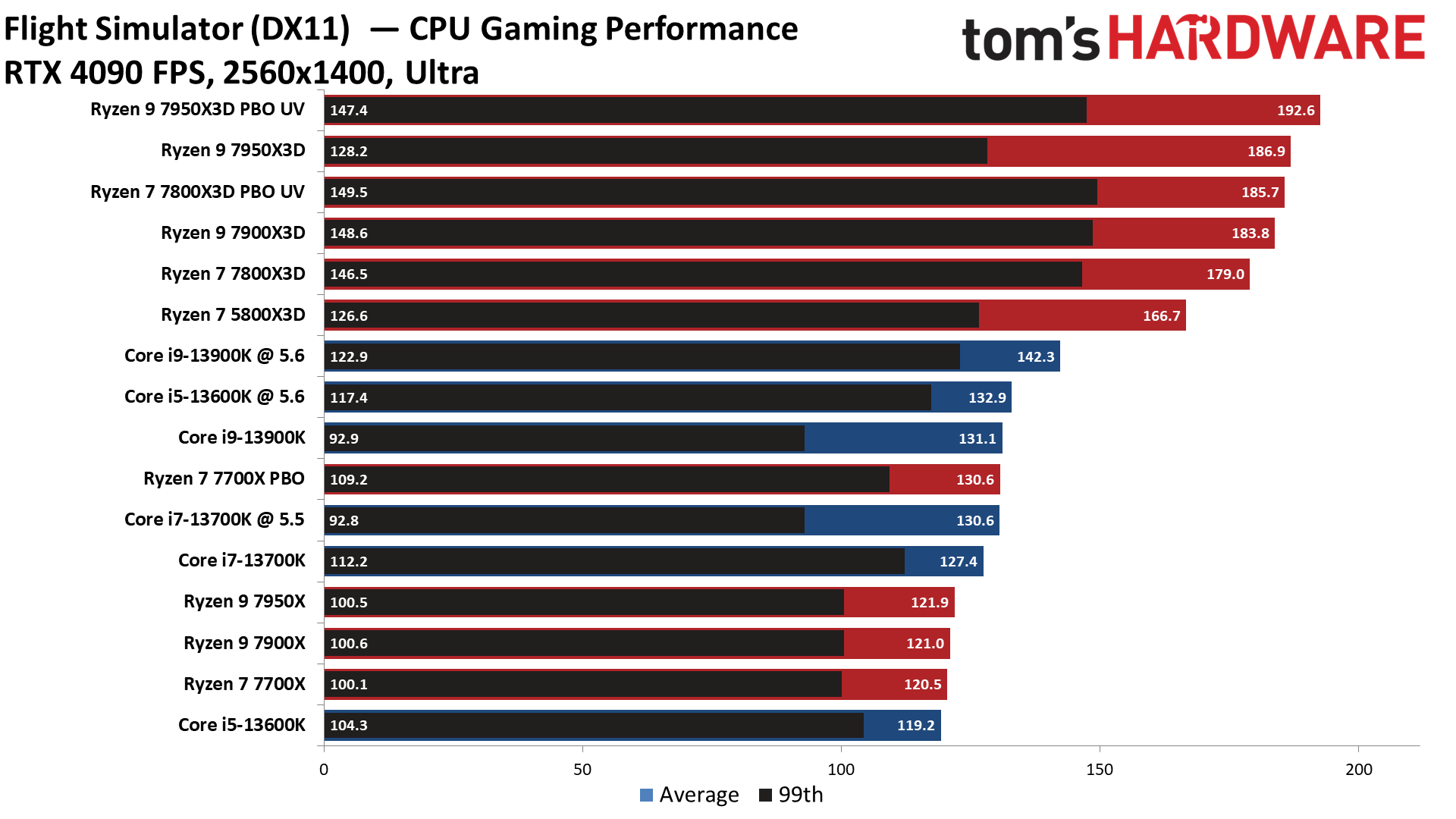
The Ryzen X3D chips' performance in Microsoft Flight Simulator 2021 is almost unbelievable — the Ryzen 7 7800X3D is 35.5% faster than the 13900K at stock settings.
Microsoft Flight Simulator 2021 obviously benefits tremendously from L3 cache, but these deltas aren't representative of the 7800X3D's performance in all titles. This illustrates how outliers can make the 7800X3D seem more impressive in cumulative measurements, so be sure to examine performance in individual games.
Red Dead Redemption 2 Benchmarks on AMD Ryzen 7 7800X3D


The Red Dead Redemption 2 chart splits into two clear classes, with the X3D chips delivering next-level performance compared to the Intel chips and standard Ryzen models.
Notably, all of the X3D models land within 2% of each other, including the Zen 3-powered 5800X3D, so it is clear that the L3 cache delivers the overwhelming amount of the uplift in this title.
Warhammer 3 Benchmarks on AMD Ryzen 7 7800X3D


Watch Dogs Legion Benchmarks on AMD Ryzen 7 7800X3D


Watch Dogs Legion closes out our testing in much the same way we saw throughout this series of gaming benchmarks; a nearly-uncontested lead for the Zen 4 Ryzen X3D chips, with the 7800X3D edging out the Ryzen 9 7950X3D to take a slim lead.
Extra AMD Ryzen 7 7800X3D Game Benchmarks - GTA V, Project Cars 3, Shadow of the Tomb Raider, Far Cry 5, Borderlands 3
After seeing some of the large deltas in our test suite, we expanded our view to a few more game titles we don't normally test. So we threw together this quick table to give a basic view of a different mix of game titles with stock processor settings.
These numbers aren't reflected in our overall geometric mean listed above but provide further context. The Ryzen 7 7800X3D provides 13900K-beating performance in a broad range of titles, ranging from -1.4% to +29.4%. Notably, the Ryzen 7 7800X3D beats the 13900K by more than 20% in four of the five tested titles and by more than 25% in three. That's simply an insurmountable advantage in this group of titles.
AMD's Ryzen 7 7800X3D Gaming Benchmarks





AMD has provided its own Ryzen 7 7800X3D gaming benchmarks for comparison. As with all vendor-provided benchmarks, you should take them with a grain of salt. We typically wouldn’t share vendor-provided tests in our reviews, but we’re making an exception because the Ryzen 7 7800X3D doesn’t improve performance in all titles, and this more expansive list provides additional context. We also provide the test notes at the end of the above album.
- MORE: AMD Ryzen 7 7800X3D vs Intel Core i9-13900K vs Core i7-13700K
- MORE: Best CPU for gaming
- MORE: CPU Benchmark Hierarchy
- MORE: Intel vs AMD
- MORE: How to Overclock a CPU
AMD Ryzen 7 7800X3D Productivity Benchmarks — The TLDR:




The first slides are simplified without the overclocking configs, while the remainder contains the full roster of tested configurations. We boil productivity application performance down into two broad categories: single- and multi-threaded. These slides show the geometric mean of performance in several of our most important tests in each category, but be sure to look at the individual benchmark results below.
The 3D V-Cache tech delivers explosive performance gains in gaming but also results in lower performance in productivity applications due to power and thermal constraints.
The Ryzen 7 7800X3D is amazing at gaming, but it struggles elsewhere. For instance, the Ryzen 7 7800X3D is most directly comparable to AMD's similar 7700X, but the latter has a 400 MHz higher boost clock than the 7800X3D's 5.0 GHz. As a result, the Ryzen 7 7700X is 7% faster than the 7800X3D in our cumulative measure of threaded applications and 15% faster in single-threaded work.
Of course, the 16-core Ryzen 9 7950X3D easily outmuscles the 7800X3D in productivity work, with 81% faster performance in threaded work and 13% faster performance in single-threaded applications.
The Core i9-13900K also beats the 7800X3D easily: it's 32% faster in single-threaded work and 89% faster in threaded applications, but that isn't too surprising given the $150 chasm between the two chips. The 7800X3D doesn't fare much better against the like-priced $417 Core i7-13700K in productivity apps, either — the 13700K is 22% faster in single-threaded and 51% faster in multi-threaded.
We see some slight gains in threaded work from overclocking the Ryen 7 7800X3D, but the 3% gain won't flip the tables on the other contenders. However, at least the 7800X3D shows a solid generational uplift, with a 26% gain in multi-threaded and a 12% gain in single-threaded performance compared to the Ryzen 7 5800X3D.
Overall, the Ryen 7 7800X3D is exactly what AMD says it is — a highly specialized chip for gaming that won't offer as much performance in standard workloads as the regular Ryzen 7000 processors. Given that the Ryzen 7 7800X3D is aimed almost entirely at the gaming market, we'll limit our commentary on the individual results below.
Rendering Benchmarks on AMD Ryzen 7 7800X3D






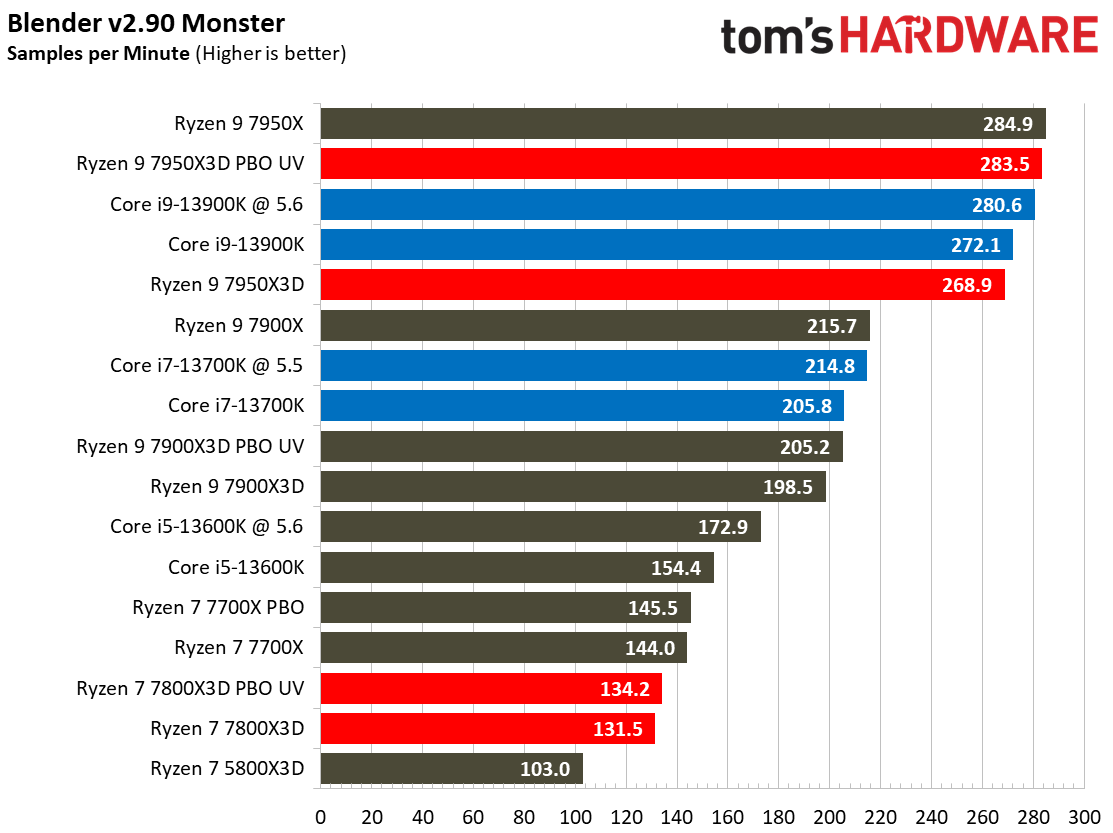





The Ryzen 7 7800X3D is significantly slower in heavily-threaded workloads than the Core i7-13700K, an unavoidable byproduct of its lower power and thermal thresholds. That same trend repeats throughout the heavy workloads.
Encoding Benchmarks on AMD Ryzen 7 7800X3D
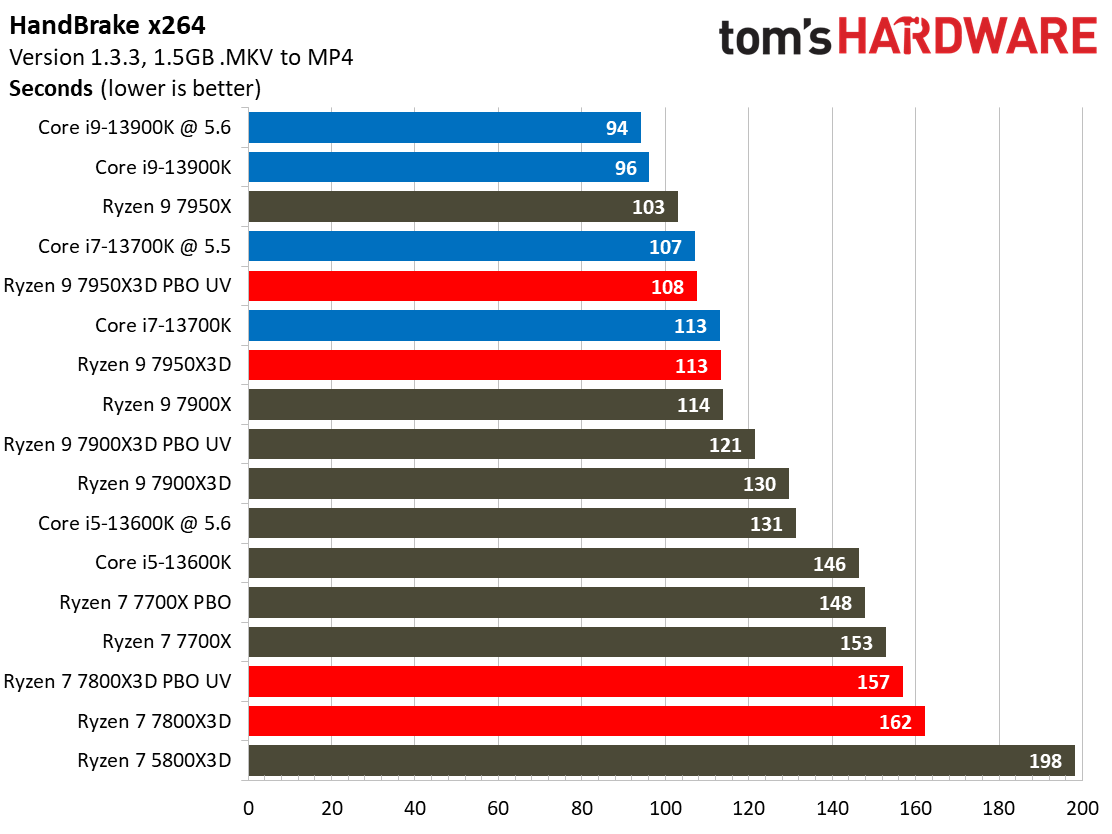
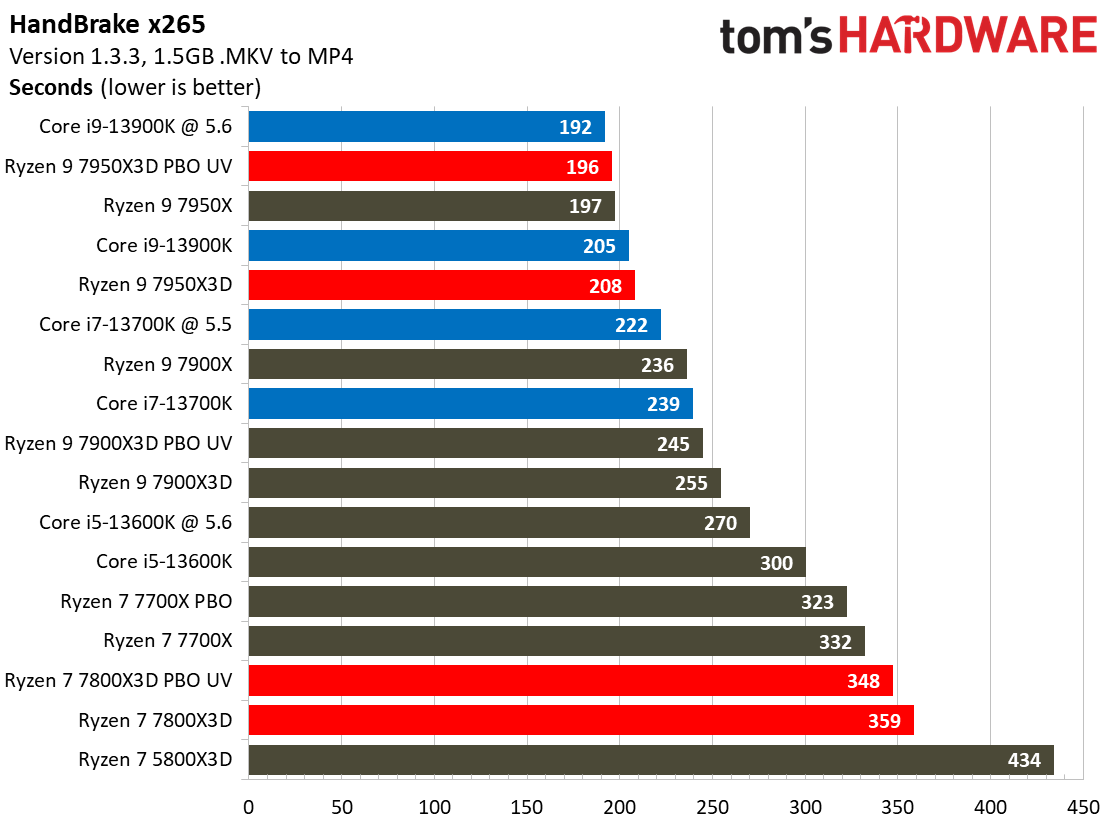

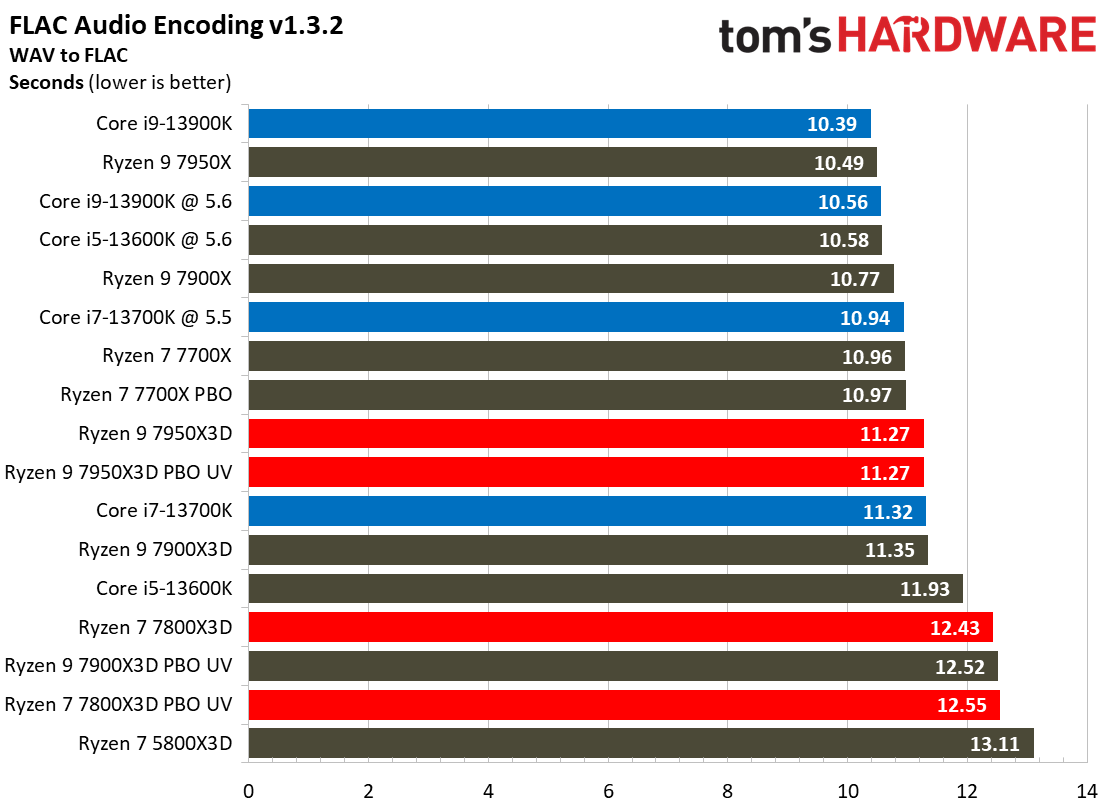





Most encoders tend to be either heavily threaded or almost exclusively single-threaded — it takes an agile chip to master both disciplines. Handbrake, SVT-HEVC, and SVT-AV1 serve as our threaded encoders, while LAME, FLAC, and WebP are indicative of how the chips handle lightly-threaded engines.
The Ryzen 7 7800X3D trails in both the lightly-threaded and heavily-threaded applications, only consistently beating the Ryzen 7 5800X3D.
Adobe, Web Browsing, Office, and Productivity on AMD Ryzen 7 7800X3D

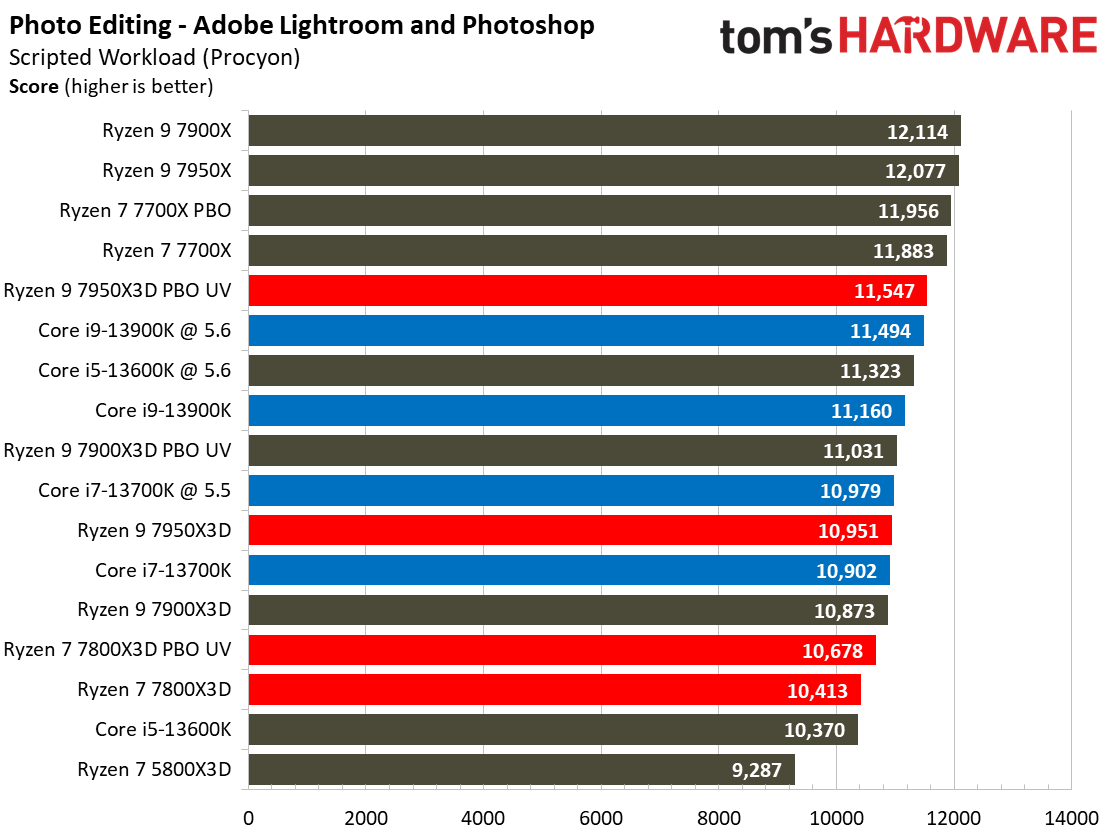




Compilation, Compression, AI Chess Engines, AVX-512 Performance on AMD Ryzen 7 7800X3D

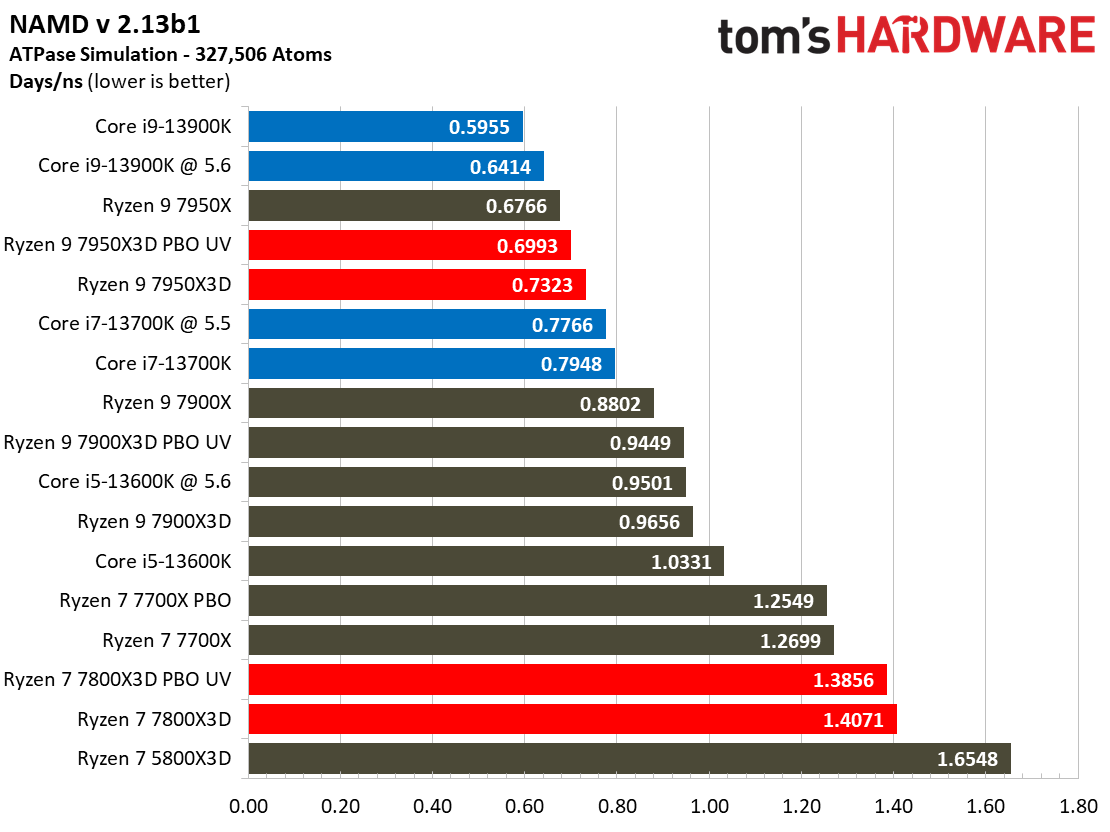












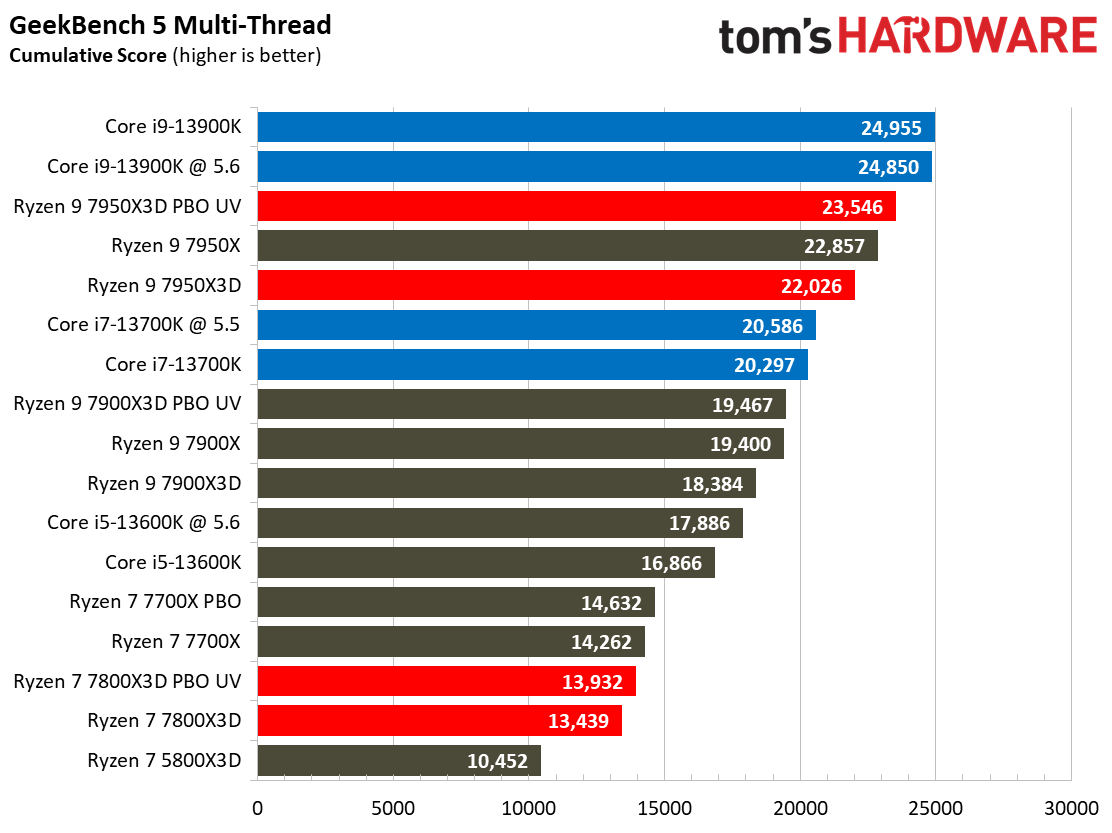

This selection of tests runs the gamut from the exceedingly branchy code in the LLVM compilation workload to the massively parallel molecular dynamics simulation code in NAMD to encryption and compression/decompression performance.
The demanding Y-cruncher benchmark computes Pi with the AVX instruction set and has optimizations for both Intel and AMD’s architectures. The Ryzen 7 7800X3D again fails to impress in any of these heavy workloads. If you're looking for solid performance in productivity applications, you'll have to look elsewhere.
- MORE: AMD Ryzen 7 7800X3D vs Intel Core i9-13900K vs Core i7-13700K
- MORE: Best CPU for gaming
- MORE: CPU Benchmark Hierarchy
- MORE: Intel vs AMD
- MORE: How to Overclock a CPU
The $449 Ryzen 7 7800X3D delivers incredible gaming performance that easily beats Intel's flagship Core i9-13900K while also dethroning AMD's own Ryzen 9 7950X3D as the fastest gaming chip on the market. However, the Ryzen 7 7800X3D is a specialized chip optimized specifically for gaming, so it trails Intel’s competing Core processors in productivity applications.
AMD's pricey Ryzen 9 7950X3D and its sibling the 7900X3D arrived to critical acclaim, but the company held back the much less expensive Ryzen 7 7800X3D until April 6. From a business perspective, that makes a lot of sense — the 7800X3D offers slightly more gaming performance for $250 less than the flagship, which doesn’t leave much reason to buy the flagship if you’re only interested in gaming.
Below, we have the geometric mean of our gaming test suite at 1080p and 1440p and a cumulative measure of performance in single- and multi-threaded applications. We conducted our gaming tests with an Nvidia RTX 4090, so performance deltas will shrink with lesser cards and higher resolution and fidelity settings.






The above slides are cumulative measurements and the 3D V-Cache tech doesn’t accelerate all titles equally — you should check our individual game benchmarks on the preceding pages to make an informed decision based on your workload.
In 1080p gaming, the $449 Ryzen 7 78000X3D is 12% faster than the $580 Core i9-13900K and 14% faster than the Core i7-13700K, making it a superior chip for gaming-focused rigs. There currently isn't an Intel processor that can compete with AMD's X3D lineup in gaming, a critical technological deficiency that Team Blue will need to rectify. The Ryzen 7 7800X3D is also faster than AMD's flagship $699 Ryzen 9 7950X3D, but the margins between the chips fall into the imperceptible range. In either case, the Ryzen 9 7950X3D now only makes sense if you're focused on productivity applications.
The Ryzen 7 7800X3D suffers from much lower performance than the standard Ryzen 7000 models in productivity applications, so you'll need to be aware of the tradeoffs. If you're looking for strong gaming performance paired with the ability to cut through heavier workloads, the Intel Core i7-13700K is a much more amenable all-rounder at $417. For instance, the 13700K is 22% faster in single-threaded and 51% faster in multi-threaded work than the 7800X3D, and you can even opt for the graphics-less $390 13700KF to save some extra cash. (You can also see a deeper look at these chips head-to-head in our Ryzen 7 7800X3D vs Core i7-13700K feature.)
If you're interested in chips that can handle heavier work but offer nearly the same gaming performance as the 7800X3D, you could step up to the $699, 16-core Ryzen 9 7950X3D or $599, 12-core Ryzen 9 7900X3D. These chips come with the multi-core heft to power through demanding productivity work while also blasting through the latest titles with the speed of 3D V-Cache. The 7950X3D has been tough to find at retail, though. (The 13900K is also an option for those with a heavier focus on productivity, we have a deeper look at it head-to-head in the Ryzen 7 7800X3D vs Core i9-13900K feature.)
Like the rest of AMD's X3D family, the Ryzen 7 7800X3D is incredibly power efficient, drawing far less power than competing Intel chips and exhibiting superb power efficiency that ranks among the best we’ve ever tested. That means you’ll ultimately benefit from a cooler, quieter system. The chip also drops into AM5 motherboards that support the latest connectivity tech, like PCIe 5.0 and DDR5, and AMD plans to support the platform until 2025+. In contrast, Intel’s current round of motherboards will only support one more generation of chips, so upgradeability remains an advantage for AMD.
Overclocking didn't yield huge jumps with our sample — we saw a roughly 3% increase across both gaming and productivity apps. That isn't an entirely bad thing, as you're basically getting all of the great gaming performance right out of the box. If you want solid performance with no fuss, just buy a nice DDR5-6000 Expo kit with tight timings and call it a day. Some motherboard vendors are working on specialized overclocking features that could net up to a 10% performance gain, but we'll have to see how that pans out in the real world before making any recommendations.
AMD's Ryzen 7 5800X3D, its first 3D V-Cache chip, arrived at the same $449 price point as the Ryzen 7 7800X3D, but it has now fallen to a mere $319, making it the go-to chip for value seekers. Given AMD's history of lower-than-MSRP pricing several months after launch, we could see the Ryzen 7 7800X3D eventually becoming another great chip for value seekers. Unfortunately, in the near term, the high-cost trappings of the AM5 ecosystem and DDR5 memory will limit the appeal of the 7800X3D if you're cobbling together a lower-cost build.
For gaming speed addicts, though, the only cure is to buy the fastest chip on the market, and the Ryzen 7 7800X3D offers a comparatively lower-cost pathway to the very best that AMD's 3D V-Cache has to offer. If you're willing to accept the tradeoffs, the Ryzen 7 7800X3D is the fastest gaming chip money can buy, earning a spot on our list of the best CPUs for gaming.
- MORE: AMD Ryzen 7 7800X3D vs Intel Core i9-13900K vs Core i7-13700K
- MORE: Best CPU for gaming
- MORE: CPU Benchmark Hierarchy
- MORE: Intel vs AMD
- MORE: How to Overclock a CPU







